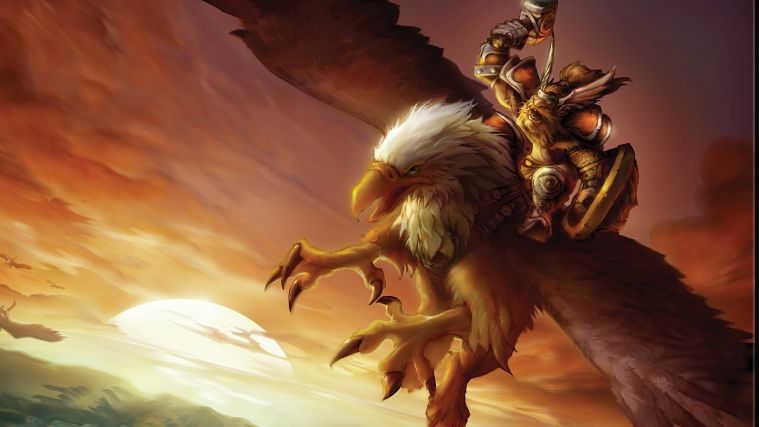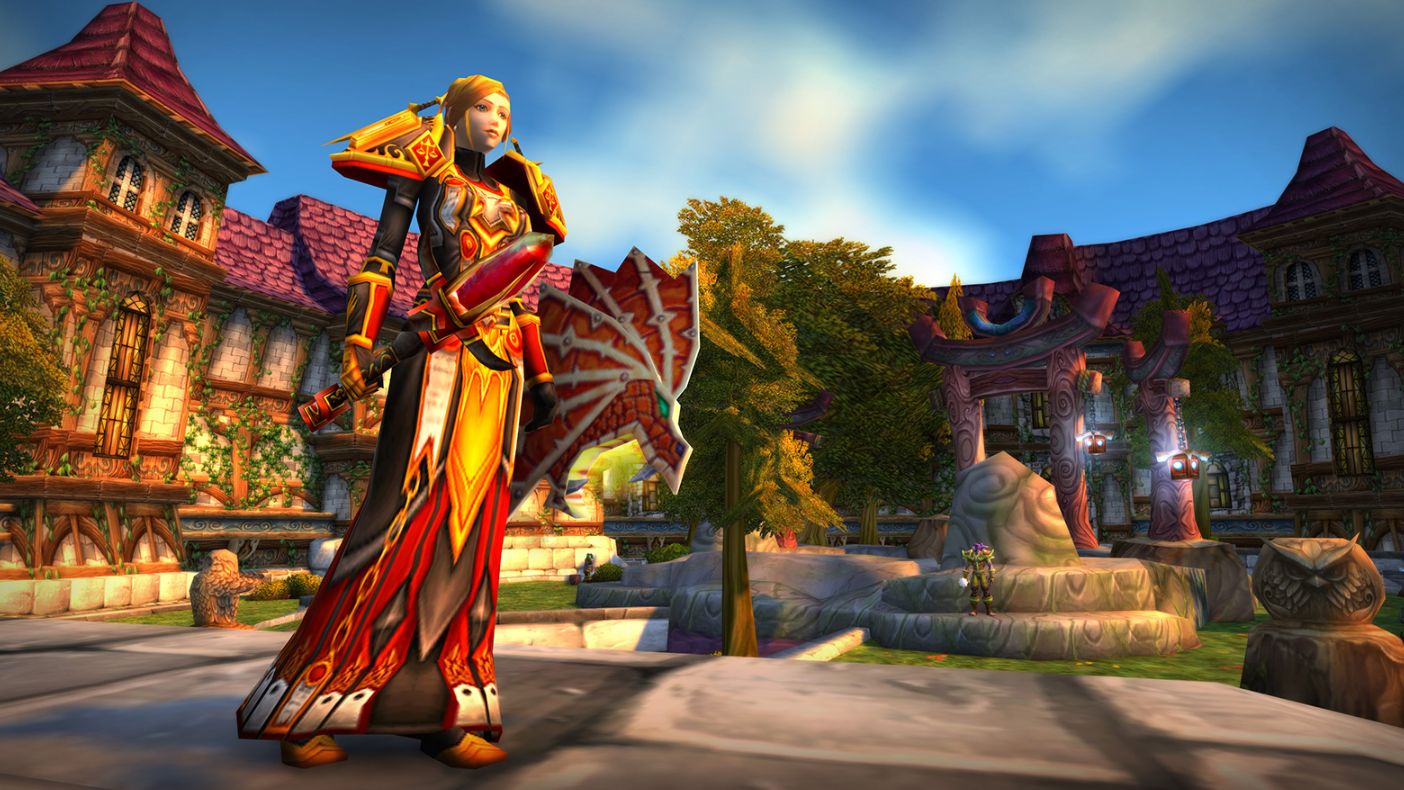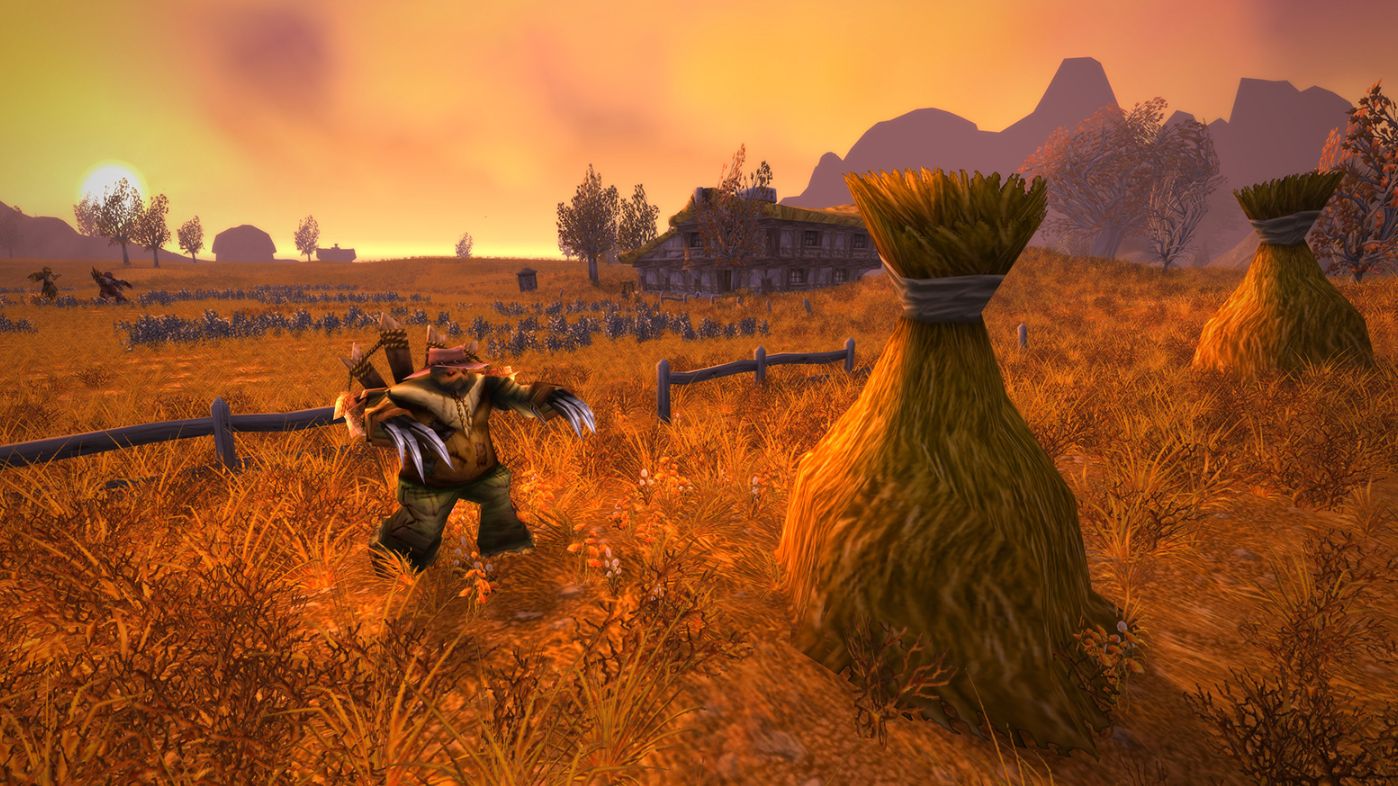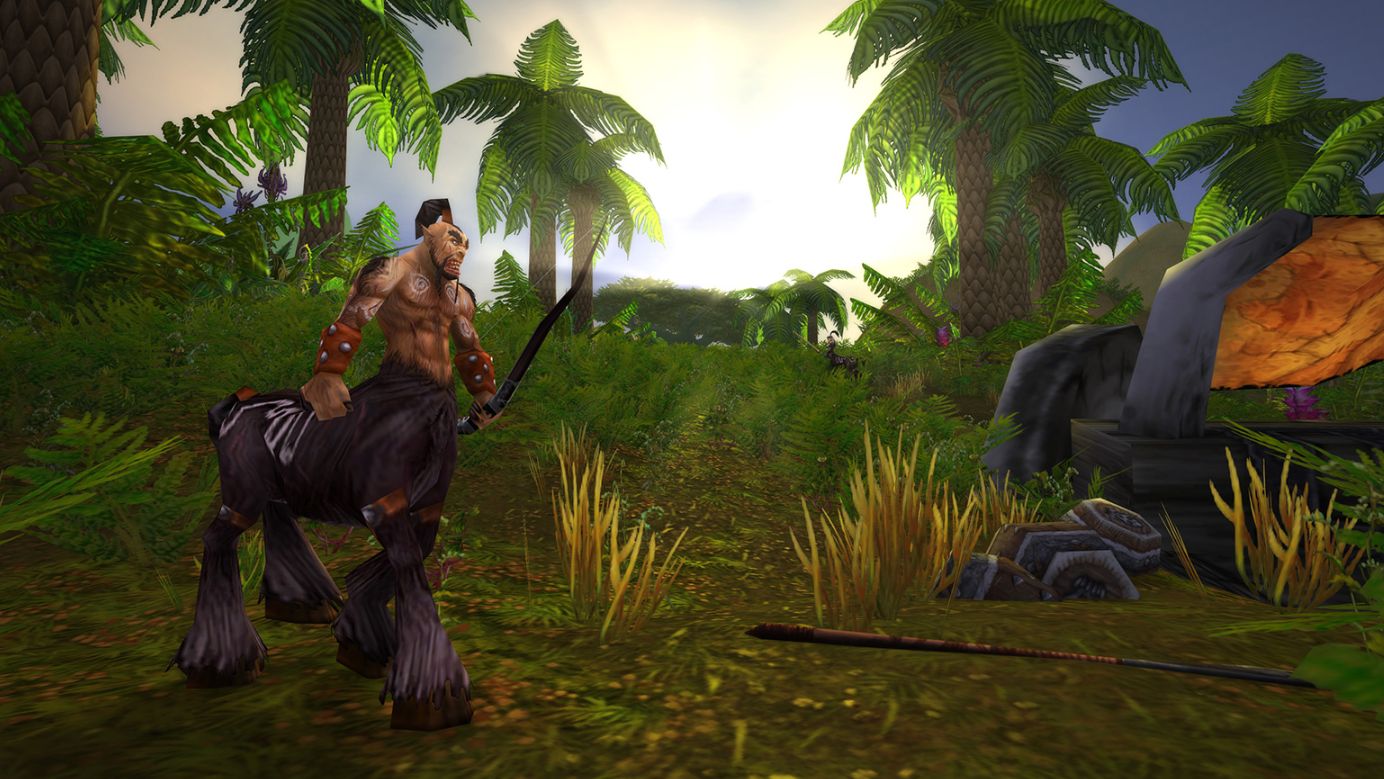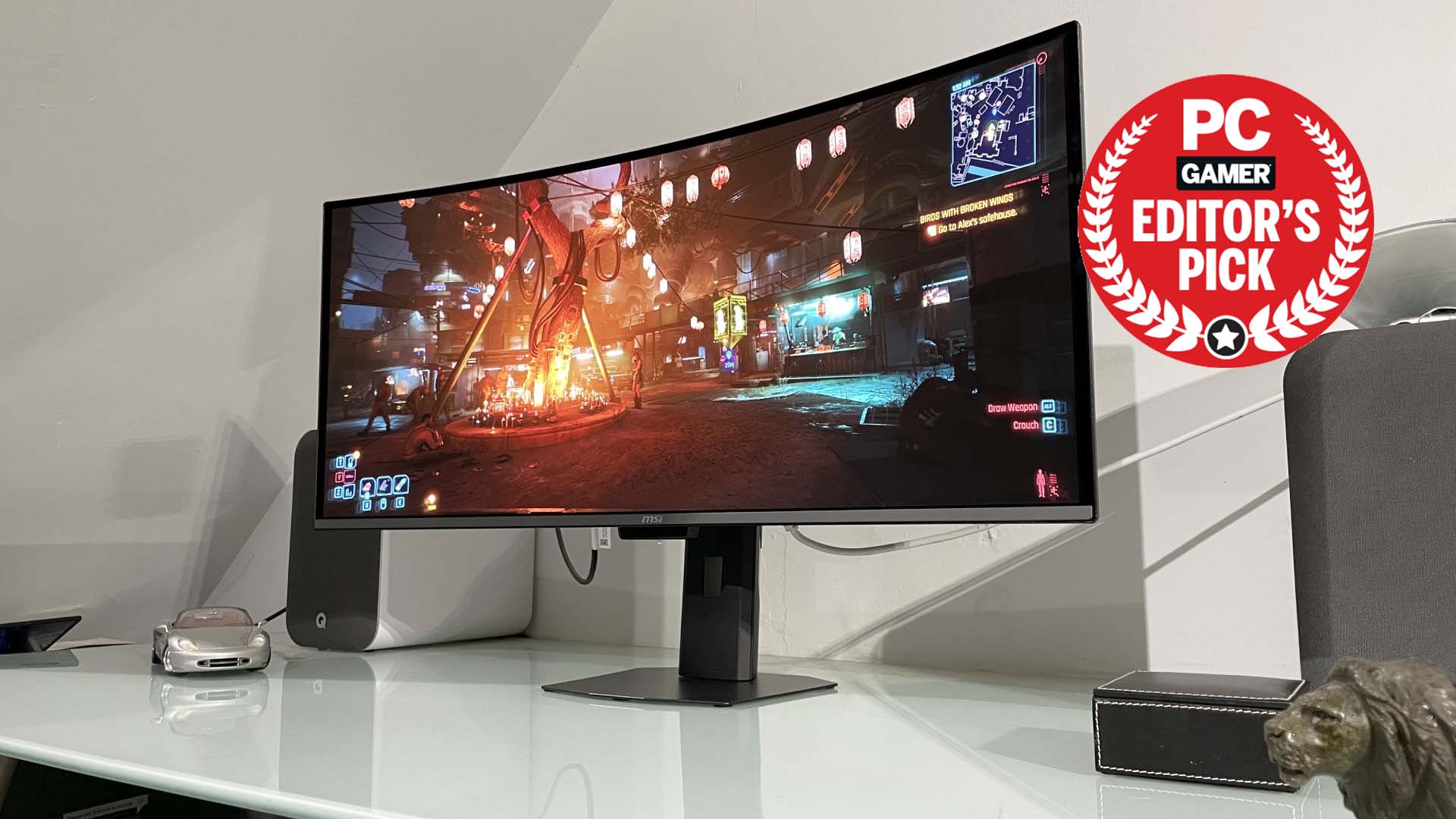Our Verdict
The best online RPG ever made.
PC Gamer's got your back
To celebrate the launch of WoW Classic we're publishing our original review of World of Warcraft. The review ran in PC Gamer UK issue 144 in December 2004. We're currently working on a fresh review of WoW Classic now the servers are live.
This review is not for the hardcore. The hardcore know the truth already, and they’ve only come here to mock my inability to get higher than level 33 before having to sit down and start writing. This review is for you, my friend. Yes, you. Because I was just like you.
In August, I had my glorious gaming autumn all lined up: Doom 3, followed by Rome: Total War and Half-Life 2—maybe a dollop of San Andreas and Halo 2 thrown in for good measure. I had absolutely no plans to play anything else outside of my usual reviewing duties, and certainly no intention of falling for either EverQuest II or World of Warcraft’s silly online worlds. I had lasted a few days in Ultima Online, little more in EverQuest, and about ten puzzled minutes in EVE Online. Those games were not for me: confusing, timeguzzling, pointless and populated with oddly behaved strangers. Is any of this ringing a bell?
Then it happened: at a press event in September I was given no choice other than to create a character and play for half an hour. The scales fell from my eyes, and my gaming habits changed forever.
The opening minutes of any MMO are crucial moment: when a gamer stands on a crossroads of experience. History is littered with the corpses of failure, such as Horizons’ “This way for quests!” signpost, and even successful games sometimes do their best to put you off with too much complexity too early. WoW’s character creation is simple – more of which later – but your opening minutes inspire an odd sensation that’ll come back time and again during your experiences: that you’re actually playing a single-player game, not one filled with hundreds of other gamers.
It’s a sensation caused in part by the sheer quality of every aspect. The interface is clear and clean. You’re well guided, but not dragged by the hand. The level of challenge, unless you go looking for trouble, is rarely too hard or too easy. Spoken dialogue is smoothly delivered but unobtrusive. You always feel like you’re doing something useful; not just bashing rats. Most of all, I never got lost or stuck, not knowing what to do next, in six weeks of playing.
A word on the presentation. Cartoony, isn’t it? Here’s the weird thing. After a while, you won’t notice—and the real world begins to look pale, dull, washed-out and out of proportion. You’ll begin to wonder why your boss doesn’t have a yellow question mark over his head. That’s not just addiction messing with your mind. WoW’s caricatured style makes more sense than it ever has, enabling a consistency that still allows for extreme variety. Believe me, the cartoon approach can still be remarkably scary.
Keep up to date with the most important stories and the best deals, as picked by the PC Gamer team.
Having said all that, some games are so good, you scarcely notice the absence of innovation. Blizzard’s gift is not to strike new veins of originality but to craft and polish existing dynamics into works of gold. World of Warcraft is simply the logical progression of ideas boldly pioneered by the likes of Ultima Online and EverQuest. The fantasy races and classes; the trade skills; magic system and player-versus-player options aren’t new. But by blending these ingredients with the existing Warcraft world, and giving them a clear sense of purpose, Blizzard have pulled their usual trick of doing it better than everyone else.
Your choice of race immediately commits you to a ‘side’ in Warcraft’s perennial struggle: humans, gnomes, dwarves and night elves versus orcs, trolls, undead and tauren.
Your choice of race immediately commits you to a ‘side’ in Warcraft’s perennial struggle: humans, gnomes, dwarves and night elves versus orcs, trolls, undead and tauren. Races have minor abilities and bonuses, but the only other limiting impact of your choice is that not all races can be all classes. Only humans and dwarves can be paladins, while taurens can’t be warlocks, rogues or mages. But beyond this, gender choice and some trivial aesthetic tweaks there’s not much to initially distinguish your starting avatar from everyone else’s.
Indeed, as you progress you’ll realise that some classes in particular have fairly limited abilities and spells, so even after many hours of play your character might be very similar to another. But here’s another masterstroke: the fun of the game doesn’t really come from your own character’s abilities and power. It’s what you do, and where you go that really matters. Like a single-player RPG, WoW’s world is carefully crafted to make you feel a part of it, and revel in it.
A sunrise over snow-capped peaks. A gryphon ride over enemy territory. A snug inn, deep in a safe city. A remote shoreline crawling with glistening horrors. Seemingly unending caves infested by strange and powerful creatures. Gathering rare herbs in dim, spider-infested glades. Mining useful ores on steep mountainsides. The thrill of stepping into a new place and knowing it’ll be like nothing you’ve seen before. Colour, lighting, architecture, flora, fauna and even minor details such as roadsigns give every location a unique identity and make it a singular pleasure just to be standing there.
But exploring WoW’s world is not simply a case of random wanderings. The seemingly endless array of quests (over 1,000) gradually guide you to new places with challenges appropriate to your strength; you can even tell if a quest will be easy or near-impossible by a simple colour code in your quest log. Knocking off a certain number of specific monsters might be an easy job, achievable alone within a few minutes. More involved tasks might involve delving to the depths of a massive dungeon, negotiating scores of monsters and retrieving a unique item; such places often have several quests attached to them so you can effectively kill several birds with one stone.
But these forbidding places often conceal particularly dangerous foes, including ‘elite’ monster types. It’s essential to band together with other players to tackle such beasties. A party of up to five adventurers can be formed using the chat channels, and the experience points and loot will be divvied up according to a variety of selectable rules. Co-operation occurs, objectives are achieved, thanks are given and friends are made. At least, that’s the theory, but group leaders can defend against cheeky members by altering looting rules, and even the unruliest player can’t really harm a player of the same faction. The same, naturally, is not true of opposing factions…
Co-operation occurs, objectives are achieved, thanks are given and friends are made. At least, that’s the theory.
Player-versus-player combat has been a staple of MMOs for years, and WoW doesn’t disappoint. Provided you plump for a PvP server, you can pick on and get duffed up by players from the opposing faction anywhere except in your faction’s safe zones; typically large towns and cities and the starting area ‘nurseries’. As such, raids by large groups of players on settlements in contested areas are often carried out just for kicks; if such antics turn you off, ‘normal’ servers restrict PvP to voluntary participation in certain areas. If you’re a care-bear.
But if you give it a go, and are unable to outrun that level 60 troll who can kill you with one blow, death is rarely a disaster. For a start, no one can nick your gear, and there isn’t even an experience point award for killing opposing faction players. Popping up as a ghost at a graveyard, corpse runs are the norm but rarely take more than a few minutes.
If you can’t bear to retrieve your corpse you can resurrect at the graveyard and take a hit to the durability of your items—effectively a small cash penalty—or if your party includes a generous healer you might expect to be resurrected on the spot, with a few minutes of resurrection sickness to endure.
Players who’ve grown used to amassing vast fortunes in Galaxies or EVE Online may be disappointed by World of Warcraft’s modest approach to personal wealth. There are no houses to buy or build and few ways to display wealth beyond a horse or other mount. There is a crafting system but it’s fairly limited. Everyone can train in all three basic skills of fishing, cooking and first aid to create basic health-recovery items and dredge up odd things from lakes. There are three further gathering professions (skinning, herbalism and mining) to choose from; and finally you can dabble in one of the six production professions: tailoring, enchanting, blacksmith, alchemy, engineering, leatherworking. Everything is useful to someone, so there is money to be made hawking your wares, but you’ll get nowhere sitting in Stormwind making the same old low-level stuff. To find new recipes, and the rarer materials needed to make them, you’ll have to head out into the wilds – as such, there’s little point ignoring either crafting or questing: the two fit perfectly.
Many MMOs claim to feature an over-arching storyline which embroil the players. The problem is that gamers are used to being the hero of every story, and this just ain’t possible for an online game (without unfeasible amounts of suspension disbelief). WoW does a smart thing by not ramming some pages-long tale down your throat at the outset. Instead, progression is accompanied by hints about the state of the world and its politics, gradually introducing the key characters along the way. There’s plenty of back-story which will particularly please aficionados of the RTS series, but note-taking is not compulsory; it’s just one more splash of colour on the game’s splendid canvas.
A decade of PC MMOs informs every design decision in World of Warcraft, just as Blizzard carefully observed the RPG and RTS in the Diablo and Warcraft series. Tweaks to common problems encountered in this genre mean annoyances and exploits are kept to a minimum. For example, it’s impossible to steal another person’s loot drops or even the experience points for killing a monster. Instances mean popular quest locations and dungeons are replicated for every character or party entering, so there’s no more queuing (though more of these hot spots would have been welcome).
The world is continuous, so the only loading screens you’ll see are when logging on, entering an instance or crossing between the two continents. There’s very little, in fact, to distract you from the world… from the sense that you’re playing a single-player RPG which just happens to have lots of other people in it.
Neither EverQuest II nor World of Warcraft entirely revolutionise the genre. But then, knowing Blizzard, we shouldn’t have expected as much. They’re not in the business of throwing out old ideas. Instead, they’ve created the finest amalgamation of existing ideas we could have hoped for, working in their rich Warcraft setting, and producing it all with such care and attention that it’s hard to see any traditional fantasy MMO being able to compete with this in the next few years. World of Warcraft lives up to its name, but it’s not a world anyone should be afraid to enter. RO
The best online RPG ever made.
